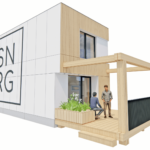Features -
Collaboration, Innovation & Construction Rebound

In this feature, Mike Smith, Director, large enterprise and public sector, Virgin Media O2 Business, writes about collaboration, innovation and the construction rebound.
Covid-19 forced the construction sector to adapt.
It wasn’t the hardest hit by restrictions because construction sites remained open during the second and third national lockdowns. But it’s faced supply chain delays, the temporary suspension of site work in Spring 2020 and increased health and safety measures.
To meet these challenges, leaders turned to digital technology to survive and stabilise. They innovated to support new ways of working and keep projects moving.
And despite being an industry traditionally resistant to digital transformation, progress has been impressive.
There’s been a 75% increase in off-site staff’s sense of wellbeing, according to Timewise. And Covid-19 has led to greater digital innovation, predicted to give way to a “platform era” in construction, according to McKinsey.
Our study with the Centre for Economics and Business Research (Cebr) shows that if the pace of digital investment continues in construction, the industry could see a £3bn boost over the coming years.
Construction leaders simply can’t afford to take their foot off the pedal.
They need to seize the opportunity. Continue investing in collaboration technologies to make hybrid working a success. Introduce innovations that can boost efficiency, overcome fragmentation and improve execution.
That way – as the country puts lockdown behind it – the sector can set itself up to rebound and prosper.
Sustaining the collaboration revolution
Fragmentation has been a challenge for the construction industry.
With lots of stakeholders involved in projects – from clients to suppliers to planners and landowners, not to mention large and small businesses –all with differing involvement at different stages of a project, communication can be challenging.
But thanks to digital transformation, the situation is rapidly changing.
Field-based digital tools are allowing any member of a build project to monitor site progress, raise and action electronic forms and communicate with others instantly – all on a mobile phone and with minimal training.
One company to benefit from state-of-the-art collaboration has been Kier Strategic Projects.
Its work on a high-tech prison building project – worth £253 million – has focused on the development of 13 fully digital buildings – forming part of a wider Ministry of Justice initiative to reform and modernise prisons, boosting rehabilitation and reducing reoffending rates.
The entire project was run using Building Information Modelling (BIM). This provided a digital representation of the physical and functional characteristics of a facility.
The technology’s great strength was that it allowed everyone to view progress through a smartphone or tablet wherever they were, enabling an unprecedented level of collaboration.
Even when COVID-19 ground most of the country to a halt, Kier’s employees, build partners and MoJ clients were able to continue collaborating through a digital cloud environment while working from home.
By choosing to invest in digital, Kier hasn’t just seen the benefits in improved ways of working. It’s also been able to win new business by offering a more streamlined approach to project management and delivery.
There are learnings for the wider industry here. As we move into a more hybrid working arrangement – with some off-site staff returning to the office – communication will be more important than ever.
Embracing state-of-the-art collaboration platforms can avoid fragmentation, boost efficiencies and ultimately improve delivery.
Embracing emerging technologies
It’s not just collaboration platforms that can make a difference.
Over the coming years, we’re going to see Augmented and Virtual Reality, advanced connectivity and even drones shake up the industry.
And it’s important that construction leaders demonstrate an ambitious and open attitude towards these new technologies. Otherwise, they could fall behind.
So far, the signs are promising. 76% of industry leaders say they are likely to invest in at least one digital innovation before the end of this year, according to Deloitte.
So, how exactly will these innovations be applied to construction?
Drones can take on a variety of roles, such as the aerial inspection of sites that are otherwise difficult to reach, as well as assisting with progress monitoring and 3D modelling. They can also prevent security breaches and uphold risk and safety management standards.
Augmented and Virtual Reality is also playing an increasingly prominent role in the industry.
XYZ Reality has already developed an AR helmet for workers to help enhance the accuracy and efficiency of projects. It gives employees the ability to see detailed holograms of building schematics in front of their eyes, helping to position objects to a 5mm accuracy. This can also be used to train apprentices by linking them with a more experienced engineer capable of giving live advice in their field of vision.
The technology is helping to reduce errors between architectural sketches and the finished buildings to an impressive extent, with XYZ claiming savings of 11% in costs and also allowing firms to exercise greater control over the number of people needing to physically go to a location.
Over the coming years, these technologies are only going to grow in significance. And it’s important not just that leaders have the right ambition, but that they make the right preparations for their adoption.
Investment in advanced connectivity solutions will ensure that a business has the tools capable of supporting technologies like VR, AR, drones and artificial intelligence, all of which involve the instant sharing of information to be effective.
Grasp the once-in-a-generation opportunity
With the national lockdown over, the future is looking bright for the construction sector.
The housing market has been booming, helped by the stamp duty break. And the launch of the new Help To Buy scheme in April 2021 brings exciting opportunities for developers.
Leaders have a once-in-a-generation moment to move the industry away from fragmentation and towards an integrated and fundamentally digital-first approach.
This will ensure that the sector doesn’t just recover but prospers.
If you would like to read more stories like this, then please click here






